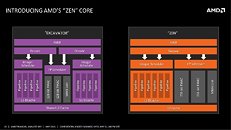Tuesday, April 28th 2015

AMD "Zen" CPU Core Block Diagram Surfaces
As a quick follow up to our older report on AMD's upcoming "Zen" CPU core micro-architecture being a reversion to the monolithic core design, and a departure from its "Bulldozer" multicore module design which isn't exactly flying off the shelves, a leaked company slide provides us the first glimpse into the core design. Zen looks a lot like "Stars," the core design AMD launched with its Phenom series, except it has a lot more muscle, and one could see significant IPC improvements over the current architecture.
To begin with, Zen features monolithic fetch and decode units. On Bulldozer, two cores inside a module featured dedicated decode and integer units with shared floating-point units. On Zen, there's a monolithic decode unit, and single integer and floating points. The integer unit has 6 pipelines, compared to 4 per core on Bulldozer. The floating point unit has two large 256-bit FMAC (fused-multiply accumulate) units, compared to two 128-bit ones on Bulldozer. The core has a dedicated 512 KB L2 cache. This may be much smaller than the 2 MB per module on Bulldozer, but also indicate that the core is able to push through things fast enough to not need cushioning by a cache (much like Intel's Haswell architecture featuring just 256 KB per core). In a typical multi-core Zen chip, the cores will converge at a large last-level cache, which routes data between them to the processor's uncore, which will feature a DDR4 IMC and a PCI-Express 3.0 root complex.
Sources:
Planet3DNow, Many Thanks to qubit for the tip.
To begin with, Zen features monolithic fetch and decode units. On Bulldozer, two cores inside a module featured dedicated decode and integer units with shared floating-point units. On Zen, there's a monolithic decode unit, and single integer and floating points. The integer unit has 6 pipelines, compared to 4 per core on Bulldozer. The floating point unit has two large 256-bit FMAC (fused-multiply accumulate) units, compared to two 128-bit ones on Bulldozer. The core has a dedicated 512 KB L2 cache. This may be much smaller than the 2 MB per module on Bulldozer, but also indicate that the core is able to push through things fast enough to not need cushioning by a cache (much like Intel's Haswell architecture featuring just 256 KB per core). In a typical multi-core Zen chip, the cores will converge at a large last-level cache, which routes data between them to the processor's uncore, which will feature a DDR4 IMC and a PCI-Express 3.0 root complex.

43 Comments on AMD "Zen" CPU Core Block Diagram Surfaces
That new top management might finally be what AMD needed to be competitive again.
Man I remember when Altivec hit and 128bit was all the rage. Course it still took software to be able to utilize it but that didn't stop Apple from rubbing it in faces.
Just google it if you want to know all about it.
Still interested to see what they've got baking in the oven though.
As for the mining bubble, they DID post a profit in late 2013/early 2014. the problem is, those super high prices? yeah, AMD didnt see any extra money from that. it all went to the manufacturers and retailers. Then, once the bubble burst and tons of used inventory hit ebay and amazon, the market for new cards tanked. once again, no money there.
The mac GPUs? yeah, also razor thin margins. going from two d500 to two d700 gpus only cost $600. you know how much those cost in desktop format? $3000. EACH. Know how much a mac pro with those gpus cost? $4600, with a 6 core i7 and 16 GB or ram, and 256GB PCIE SSD. so, once again, razor thin margins.
Zen could turn it around. Llano APUs sold great with oems, but amd torpedoed that with bulldozer. AMD had a good thing with the enthusiast market with the phenom II. again, bulldozer torpedo. GPU wise, they sat on GCN way to long, giving nvidia the chance to dominate the market for almost half a year with maxwell, which has destroyed AMDs marketshare. zen needs to be good, and the 300 series needs to be really good, or else amd wont make it.
Be a fan of hardware, not a fan of a brand.
AKA, if i gave you $230 to buy a CPU, are you getting a 4690K or a FX5950? (i'd say at least, i don't know, 97% are going with the 4690K)agree, hoping AMD offers a truly competitive product, both price and performance wise. I think most people stick with Intel CPUs right now because they are simply objectively better in nearly every way.
Hopefully this is a good architecture like the leaks hint it to be.
Hating on AMD products is a waste of energy. The current AMD products provide good performance and excellent value. If that's not for you then buy from the convicted criminals at Intel. It's your dime. If not for AMD you'd be paying $1000 for a current Intel run of the mill CPU.
People shouldn't be asking what Zen performance will be like, they should be asking what will Intel's response to it perform like...
Sorry, but what do you expect when AMD's top CPU gets beaten in virtually every performance metric by an Intel CPU that costs $50 less, and offers things like PCI-Express 3.0, which AM3+ does not support?
Delusional fanboys who ignore basic facts make no sense to me.